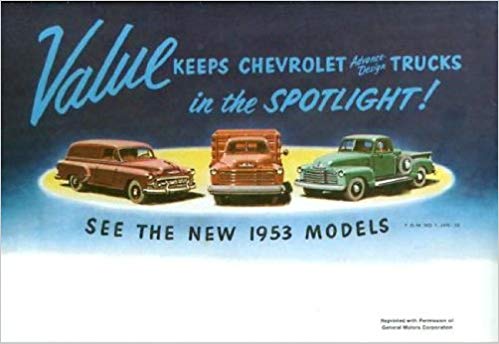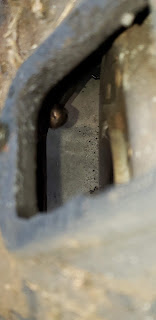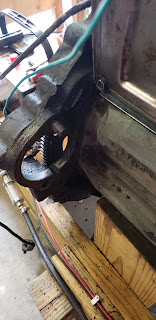Well, the subject line is a clue to something being amiss.
As I closed the last post, I made the statement that I was one good day in the garage away from being ready to transplant that engine into the Gray Ghost. I took a mental health day last Thursday to have that day. So I retrieved the clutch kit that I had bought many months ago and set about installing it onto that beautiful flywheel. It proved to be a bit fiddly, mostly because of the engine sitting low on the engine stand and the reduced hand/forearm strength from the RA. Regardless of the cause, I quickly figured out that lifting it into position with one hand and screwing in a bolt with the other wasn't going to work. What to do? Build bracing (stacked pieces of wood) to raise it up until it was at the right height. When finished, it looked like this:
What I would do is lift with one hand and shove another board under the clutch cover with another. Once it was at the right height, I got the top bolt installed. After that, I had to rotate the engine to bring each bolt into view. I chose to attach the bolts at the bottom, not the top, as the access is easier from the bottom. When done, it all looked like this:
In this shot, you can see the alignment tool in the center of the pic. This plastic tool engages the splines of the friction disk and holds it in place while you bolt up the clutch cover. The alignment tool goes into the pilot bushing, which is how it holds everything in place.
After installing all of the clutch parts, it was time to move onto the clutch throwout fork. This was first contact with the enemy. In the above pic, above the cast number "10" you can see a round something. This is the back side of the screw in stud that the throwout fork snaps into. The throwout fork looks like this:
The end on the left is where the fork attaches to the linkage that connects it to the clutch pedal. The round area on the right is what snaps onto the stud. It bows in the middle, under the part number that is cast into the part. To install the fork, you slide it through the large opening in the center of the bell housing and through a slot on the driver's side of the bell housing. When I did this, it became clear that there wasn't enough clearance for the clutch fork to fit between the clutch cover and the stud. Wiggle, wiggle, wiggle, no. Try from the other side, no. Try to rotate it, no. Nothing. By this point, I've been out there for hours and nothing is working. Time to take a break and reach out to my forum buddies.
I got a couple of suggestions, but nothing concrete. In the interim, I decided to measure the thickness of the flywheel that was just mounted in the replacement engine and compare it to the thickness of the one in the dead engine. Come to find out, the heavy duty flywheel that I was so proud of was a 1/2" thicker that the one in the dead engine. So then, I decided to see how much clearance that engine had between the stud and clutch cover. Lo and behold, about a 1/2" more than the replacement engine. Viewing inside the inspection covers of both engines looked like this:
Dead engine clearance
Replacement engine clearance
While discussing this with my friends, I came up with the idea of removing 5 of the 6 bolts that hold the clutch cover in place and loosening the 6th bolt, while positioning it at the 12:00 position. This would allow me to swing the clutch cover to the passenger side while trying to snap the clutch fork into position. I set it up...and it worked! I then reattached the 5 bolts. Then it was time to test fit the throwout bearing...and it doesn't fit into the clutch fork. Not without pressing it hard against the fingers of the clutch cover. Time to go back to the forum and ask for advice. Can the throwout bearing ride against the clutch cover fingers or not. The answer came back: No! Game, set and match. It all has to go.
So now, I have to remove the clutch kit entirely (and try to return). Then I have to remove the heavy duty flywheel (and try to sell it). Then it's off to the old engine.
Once I'm done with the replacement engine, I will have to remove the old clutch and flywheel from the dead engine and inspect that flywheel for possible re-use on the replacement engine. If it is in good enough condition to be re-used, I'll have to have it resurfaced. Then I have a decision to make: stick with the 6V ring gear or buy a 12V ring gear and swap it out.
The difference between the two is that the 6V ring gear has 132 teeth to the gear and only works with a 6V starter. The 12V ring gear has 168 teeth and only works with 12V starters. They are intentionally not interchangeable. I can use the 6V starter with my 12V truck. It'll spin faster, but engage harder than usual, so the ring gear will get a beating. The unknown right now, is whether or not the old starter in the dead engine still works. Once I get the flywheel out of the dead engine, I'll hook up the jumper cables and see if the old starter will work. If it does, then I'll probably stick with that. If not, then I'll have to buy a replacement ring gear and swap it out. To do that, you have to heat the ring gear enough to make it swell, so that it can be knocked off of the flywheel. Then you heat the replacement enough that it can be fit to the flywheel and can cool and shrink to a tight fit.
So that's it. One step forward, two steps back. It's all a part of my learning process. Hopefully, all it costs me is time and not too much money. What it does do, though, is keep me from installing the engine right away. The fall is slipping away from me and the cold weather will be here soon. Once that happens, if the engine isn't in the truck, it probably won't go in until spring.
Stay tuned, I'll keep you up to date.
Here's a somewhat random, certainly unrelated pic.
Who knew deer could climb stairs, just to go after the pumpkins on your porch?!? Who knew that they could get down?!? And yes, the pumpkins ended up in the front yard with parts missing and eaten.




















